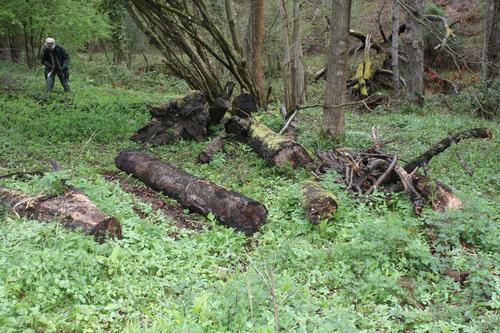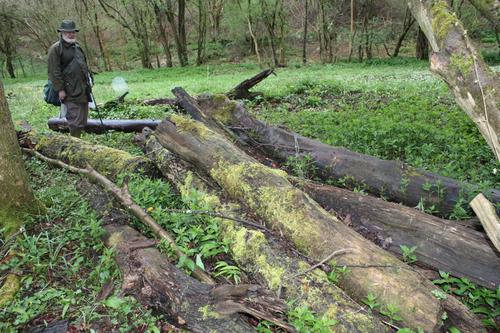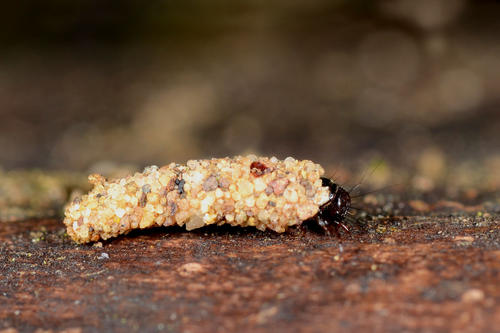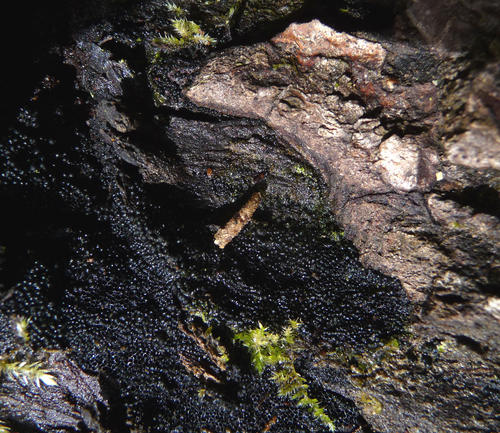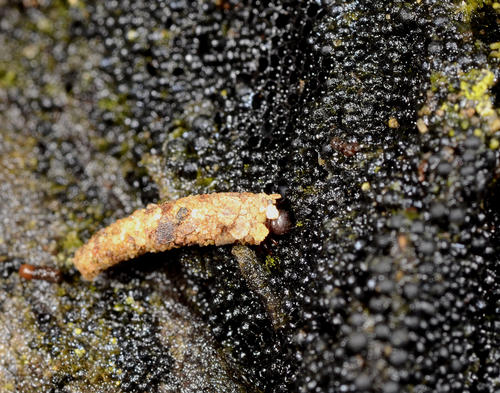Climbing Land Caddis Enoicyla pusilla in Wyre Forest
Harry Green
On the 20th April 2012 members of the Wyre Forest Study Group (WFSG) were led by Brett Westwood and others to the Dowles Brook near Dowles Manor in search of Lampreys. Unfortunately run-off from recent heavy rain had caused considerable turbidity and this and raised water levels in the brook made a search almost impossible. However, the Group stopped for lunch at a collection of wet logs (Figs. 1 & 2.) on wet ground (SO772764), and soon discovered many (at least 50) Land Caddis larvae (Fig. 3.) actively climbing up the logs and several apparently browsing on a patch of black slime-mould (Figs. 4 & 5).
Several WFSG re-visited the site again on 28th April 2012 following yet more wet weather. Rosemary Winnall wrote:
“We revisited the logs this morning at 9.30am and counted 30 land caddis as before up to 6 inches off the ground. We measured several and they were between 7 and 9 mm in length. Someone had rolled one of the logs as you can see, but we left it as there were several caddis up on the side. There were two on that patch of black slime mould. Interestingly Mike Averill went to photograph the logs with land caddis yesterday afternoon and found none! He and Will Watson set off down there again at 4.30p.m. this afternoon after a day without rain to see if they could find them - we look forward to hearing what they found!”
Mike Averil wrote: “Interestingly there were only a handful showing by 4.30 p.m.. Will and I managed to get some pictures but they were as numerous as in the morning. None on our favourite slime mould patch”.
Land caddis larvae usually live within leaf litter in woodlands. Green & Westwood (2005) wrote: “Although not aquatic, Land Caddis larvae require a relative humidity of near 100%, although they can survive in drier conditions for a short time. They lack gill filaments and respiration is through the skin. If they are soaked by heavy rain they will climb up vegetation, for example low brambles, and hang themselves out to dry, dropping down again when relative humidity falls below 70%. This behaviour probably explains the origin of Hickin’s larvae invading a tent. We have occasionally seen many larvae together on the surface of mosses and liverworts growing on a stream bank following rain, and we have an entomological friend who passed a sweep net through low bramble in Wyre Forest and was astonished to collect many Land Caddis larvae”.
This note reports what is probably another example of land caddis larvae climbing to escape from very wet ground conditions. AS far as we are aware there are no reports of Land Caddis larvae eating fungi or slime moulds. Even in this instance we cannot be sure they were actually consuming the slime mould although their mouthparts appeared to be moving when the larvae were static on the mould.
Reference
Green, G. H. & Westwood, B. 2005. In search of the land caddis. British Wildlife 17(1):21-26.
Images
Fig. 1 Land caddis larvae climbed these logs in wet conditions. Rosemary Winnall
Fig. 2. Land caddis larvae climbed these logs in wet conditions. Rosemary Winnall
Fig. 3. Land caddis Enoicyla pusilla larva. John Bingham
Fig. 4. Land caddis Enoicyla pusilla larva on slime mould. Harry Green
Fig. 5. Land caddis Enoicyla pusilla larva on slime mould. John Bingham
